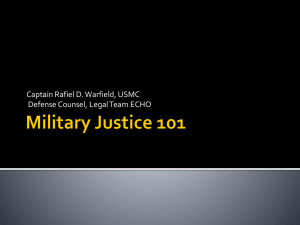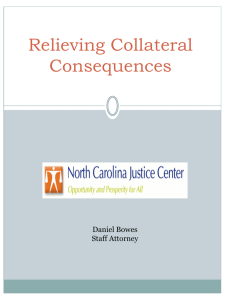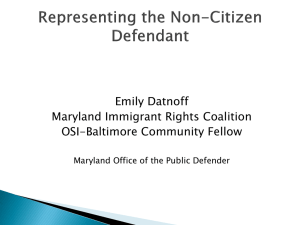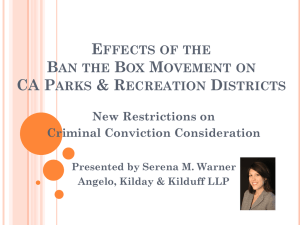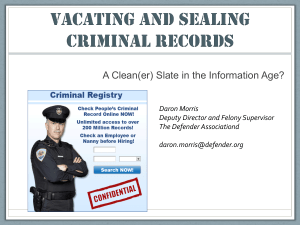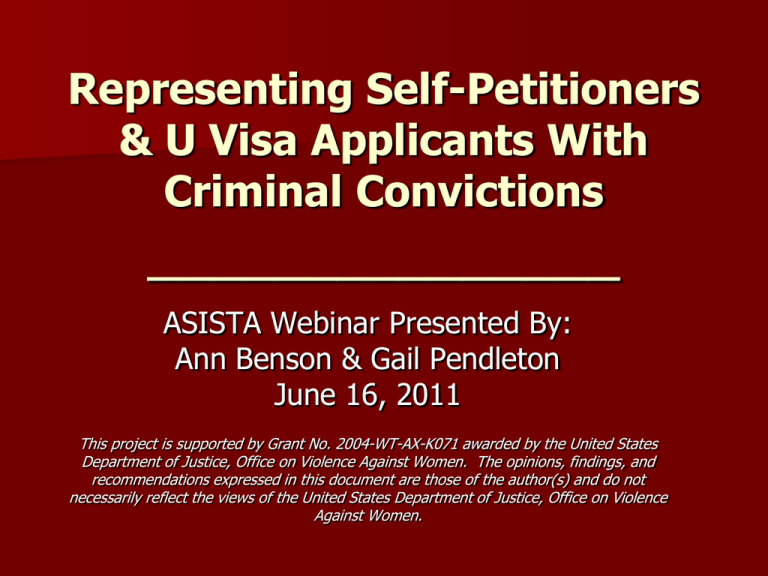
Representing Self-Petitioners
& U Visa Applicants With
Criminal Convictions
_______________
ASISTA Webinar Presented By:
Ann Benson & Gail Pendleton
June 16, 2011
This project is supported by Grant No. 2004-WT-AX-K071 awarded by the United States
Department of Justice, Office on Violence Against Women. The opinions, findings, and
recommendations expressed in this document are those of the author(s) and do not
necessarily reflect the views of the United States Department of Justice, Office on Violence
Against Women.
Getting Help On Your Case
The Washington Defender Association’s Immigration
Project is part of the ASISTA team and available to
provide case analysis and problem solving to immigrant
survivor advocates.
To contact WDA’s Immigration Project for assistance
email
– Jonathan Moore at jonathan@defensenet.org
– Ann Benson at defendimmigrants@aol.com.
You can also call us at 206-623-4321.
Goals of Presentation
Provide an overview of primary crime-related
provisions of immigration law
Outline key concepts in analyzing the
immigration consequences of criminal
convictions
Apply this information to more effectively
represent self-petitioners and U visa applicants
with criminal issues.
Overview of Presentation
Convictions & Sentences Under Immigration Law
Criminal Grounds of Inadmissibility
Criminal Grounds of Deportatibility
The Aggravated Felony
The Good Moral Character Bar
The Categorical Analysis
Necessary Tools
Immigration & Nationality Act (INA)
– a.k.a. Title 8 United States Code (USC)
Copy of the criminal statute at issue;
Copy of the criminal record of conviction;
Access to immigration & crimes resources
Necessary Tools
For assistance in obtaining the necessary
criminal documents (plea agreement, charging
document, judgement & sentence, police report)
see:
Step One In Representing Noncitizens With
Criminal History: Obtaining Relevant
Information About the Criminal Case,
by Ann Benson, Asista Newsletter Winter 2008,
available at www.asista.org
Necessary Tools
Immigration & Crimes Resources
WDA’s Immigration Project: www.defensenet.org
Immigration Advocates Network:
– www.immigrationadvocates.org
Defending Immigrant’s In the Ninth Circuit, by Kathy
Brady et.al, and other materials from:
– The Immigrant Legal Resource Center www.ilrc.org
Immigration Law and Crimes, by Dan Kesselbrenner and
Lory Rosenberg
– National Immigration Project
www.nationalimmigrationproject.org
Primary Crime-Related Provisions of
Immigration Law
Definition of Conviction & Sentence
INA 101(a)(48);8 USC 1101(a)(48)
Grounds of Inadmissibility
INA 212(a)(2); 8 USC 1182(a)(2)
Grounds of Deportability
INA 237(a)(2); 8 USC 1227(a)(2)
Aggravated Felony Definition
INA 1101(a)(43);8 USC 1101(a)(43)
Good Moral Character Bars
INA 1101(f); 8 USC 1101(f)
Analyzing the Impact of A
Conviction or Criminal Conduct
Does client have a conviction under INA
§101(a)(48)(A)?
NO – does the conviction trigger any “conduct” based
grounds?
YES – Determine sentence under INA 101(a)(48)(B).
– Use categorical analysis and other tools to explore arguments
that crime does not trigger immigration penalty. Existence of
conviction vs. “nature” of conviction – e.g. not all assault
convictions are CIMTs.
Identify possible waivers.
Convictions Under INA 101(A)(48)(A)
Formal judgment of guilt by court, OR
Deferred Adjudication = conviction if:
Finding of guilt or
Admission of guilt or
Admission of Facts Sufficient to warrant finding of
guilt
AND
Judge orders punishment or restraint
Jail, $ Fine or Probation = restraint
Convictions Under INA 101(A)(48)(A)
Deferred/Withheld Adjudications
– Often used in minor first-time offenses where
defendant agrees to comply w/conditions for period
and then case dismissed.
– These are convictions under immigration law forever
where deferral agreement requires admission or plea
of guilt OR stipulation to “facts sufficient”.
Even where successfully completed and dismissed
Critical to get a copy of the deferral agreement.
Convictions Under INA 101(A)(48)(A)
These DO NOT = convictions under 101(a)(48)(A):
Juvenile disposition (in juvenile court);
Conviction on direct appeal of right;
Infractions (distinct from convictions b/c no jail
time possible – e.g. speeding ticket).
Post Conviction Relief
PCR “vacations” eliminate conviction if record
shows granted due to underlying legal defect
not just for immigration purposes
Most state “expungements” do not eliminate
conviction for immigration purposes
PCR to modify sentence (e.g. 365 to 364) WILL
be given effect (regardless of basis)
Convictions – Key Questions
Do the applicable immigration
provision(s) require a conviction?
If so, based on the criminal records, does
your client have a conviction under INA
101(a)(48)(A)?
Sentences Under Immigration Law
INA 101(a)(48)(B)
Includes the period of incarceration or
confinement ordered by a court
regardless of any “suspension” of the
imposition or execution of the sentence.
• Example: 365 days imposed with 364 days
suspended = 365 for immigration purposes.
Sentences Under Immigration Law
• Certain misdemeanors with 365 day sentences =
aggravated felonies (e.g. theft and assault).
• Exceptions:
• Certain Bars triggered by amount of time served regardless
of actual sentence imposed
• Example: GMC bar where 180 days served
• Crimes Involving Moral Turpitude (CIMT)
• Inadmissibility Ground Petty Offense Exception
• Deportation Ground – 1 CIMT
Definition of Sentence
INA 101(a)(48)(B)
“Deferred Sentences” do not count if no actual
time was imposed on judgment
Review your state law re: deferred vs. suspended
sentences
Does not include any period of probation or
community custody UNLESS imposed as
condition of sentence or probation violation.
Sentences – Key Questions
Determine actual “sentence imposed”
(regardless of time suspended).
Determine if possible crime-related
immigration provisions are triggered due
to the sentence.
– Example: Theft conviction is an aggravated felony IF
one year sentence imposed.
Convictions & Sentences – Review Questions
Angela is charged with misdemeanor theft.
Would the following be a conviction? If
so, what is her sentence? What additional
information would you want?
– 12 month deferred adjudication agreement?
– Guilty plea with 12 month deferred sentence?
– Plea w/365 day sentence imposed with 364 days
suspended (1 day to serve)?
Crime-Related Inadmissibility Grounds
INA 212(a)(2); 8 USC 1182(a)(2)
GENERALLY APPLY TO:
Any noncitizen seeking entry to US
Any noncitizen applying for lawful status
When ICE /DHS seeks to remove/deport
Undocumented persons who illegally entered US
LPRs who apply for citizenship
Inadmissibility Grounds- INA §212
Apply to VAWA Self-Petitioners:
Filing of I-360
– Good moral character (GMC) bars incorporate
most of the crime-related inadmissibility bars
Adjustment of status
– Must prove not inadmissible under INA 212
Inadmissibility Grounds- INA §212
Apply to U Visa Applicants:
Filing of U Visa
– Must prove not inadmissible under INA 212
Filing of U Adjustment
– INA 212 DOES NOT APPLY
Crimes Involving Moral Turpitude –
CIMT Offenses
INA 212(a)(2)(A)(i)(I)
– CIMT not defined – caselaw defines
– Generally conviction required
Juvenile offense Exception Committed before 18 AND
5 yrs before admission
Petty Offense INA Exception One CIMT offense
Maximum possible sentence not > 1yr ;
Actual sentence not > 6 months/180 days
CIMT Offenses
Practically, requires conviction to trigger
INA permits qualifying “admissions” to
trigger, however:
– Seldom invoked
– Significant procedural requirements apply
– Consult with experts before admitting to any
non-conviction criminal activity
Controlled Substance Violations
Drug defined under Controlled Substances Act (CSA)
Applies to convictions (usual) and qualifying admissions
(rare)
Applies to attempt, conspiracy and foreign convictions
Possible waiver for first-time simple possession of 30g or
less marijuana (or lesser offense (e.g. possession of
paraphernalia)
Multiple Convictions
INA 212(a)(2)(B
2 or more convictions where aggregate
sentence is 5 years or more
– Only applies where TOTAL combined
sentences = 5 years
Conduct-Based Inadmissibility Grounds
No conviction required
Reason to believe involvement in drug
trafficking
– Drug must be listed in CSA
Determined to have physical/mental
disorder that poses threat;
Determined to be drug abuser;
Engaged in prostitution.
Reason to Believe-Drug Trafficking
INA 212(a)(2)(c)(i)
Involved, aided, abetted, conspired, colluded in
illicit drug trafficking
Drug listed in Controlled Substances Act
Knowing and conscious participation
Trafficking = remuneration
Lopez-Umanzor v. Gonzales, 405 F.3d 1049 (9th
Cir. 2005)
RTB – Family Members
INA 212(a)(2)(C)(ii)
Spouse, son/daughter of person inadmissible
under (C)(i)
Obtained financial benefit from the illicit drug
trafficking
Knew or reasonablyshould have known benefit
was from illicit drug activity
Drug Abusers
INA 212(a)(1)(A)(4)
Non-medical use of drug in CSA
No requirement that use result in physical
or psychological addiction
Single use of marijuana/amphetamines OK
Only inadmissible if used w/in last 3 yrs
Engaged In Prostitution
INA 212(a)(2)(D)
Applies to prostitute, procurer (pimp) but not
customer (john)
“Engaged In” = continuity & regularity indicating
pattern of behavior
– See State Dept. Regulation – 22 CFR 40.24(b)
Sexual Intercourse for hire
One-time incident insufficient
Foreign prostitution where permissible triggers
212(h) Crimes Waiver
INA 212(h)(1)(C) - Only for self petitioners
DOES WAIVE:
–
–
–
–
CIMT offenses
Multiple criminal convictions
Prostitution
Controlled substances violation IF <30g mj
DOES NOT WAIVE others, including RTB
“Violent & Dangerous” offenses will require showing of
extraordinary circumstances
U Visa Waiver
INA 212(d)(14) – only for U visa applicants
Gives government discretion to waive ANY
crime-related inadmissibility ground.
Must show “extraordinary circumstances”
if crime was “violent or dangerous”.
Inadmissibility Review Questions
Diana is a U Visa applicant. How will the
following impact her? What additional
information would you want to know?
What would you do if it triggers a ground
of inadmissibility?
A misdemeanor theft conviction?
A DV assault conviction?
A conviction for attempted possession of
cocaine?
Crime-Related Deportation Grounds
INA 237(a)(2); 8 U.S.C. 1227(a)(2)
Applies to remove noncitizens lawfully admitted:
–
–
–
–
LPRs, CPRs, asylees and refugees;
Nonimmigrant visa holders (even if expired)
Approved U visa applicants
Do not apply to I-360 & U visa applicants
Bars eligibility for VAWA & 10 year cancellation
Otherwise, inapplicable unless lawfully admitted
Distinct from inadmissibility grounds
Conviction required (one exception).
CIMT Offenses
One CIMT – INA 237(a)(2)(A)(i)
•
•
Committed w/in 5 years of admission
Carry maximum POSSIBLE sentence of 1
year or more
Two CIMTs – INA 237(a)(2)(A)(ii)
– Regardless of when committed or sentence
– Single scheme of conduct exception
Grounds of Deportability
Aggravated Felony (see next section)
Controlled substance violations
– Exception: single offense for simple
possession of 30 grams or less
Firearms convictions
DV & No Contact Order Violations
Domestic Violence Convictions-INA
237(a)(2)(E)(i)
– After Sept. 30, 1996
– Must be crime of violence per 8 USC 16
– Committed against person (not property)
– w/whom Defendant has qualifying relationship
Judicial “determination” of Protection/no
contact order violation INA 237(a)(2)(E)(ii)
– No conviction required
Deportation Review Questions
Cindy became an LPR in 1995. Last week
she was convicted of drugs possession.
How could it be possible that she would
not be deportable?
Would she be deportable if her conviction
was for theft instead? What additional
information would you need?
Aggravated Felony Definition
INA 101(a)(43);8 USC 1101(a)(43)
21 provisions under definition
– incorporates hundreds of offenses
Triggers harshest consequences
– Mandatory detention
– Permits expedited removal under INA 238(b)
– Ineligibility for many benefits/status
– Increased sentence for illegal reentry after
deportation conviction
Aggravated Felony Definition
U Visa Applicants
– AF definition does not apply at application
– Will be basis for removal of approved U Visa
applicant
But does not bar adjustment U adjustment.
Self-Petitioners
– AF conviction is a GMC bar
– Does not apply to S/P adjustment application.
Aggravated Felonies (AF)
State classification irrelevant –
misdemeanors can be AF
– E.g theft w/365 day sentence
Highest priority for removal
Conviction required
Increases sentence enhancements in
illegal reentry prosecutions
Selected AF Provisions
Murder, rape, Sexual Abuse of a Minor
Drug trafficking
Firearms offenses
Crimes of violence with one year sentence
– Regardless of any suspended sentence time
Selected AF Provisions
Theft, Possession of stolen property, burglary
with one year sentence imposed (365 days)
– Regardless of suspended time
Crimes of fraud or deceit where loss = $10k or
more
Failure to appear
Attempt or conspiracy to commit listed AF
Aggravated Felonies – Review Questions
Are the following convictions AF:
– Misdemeanor assault w/365 day sentence?
– Felony Assault with 6 month sentence?
– Theft with 365 day sentence where 364 days is
suspended?
– Burglary with 12 month sentence?
– DUI with 365 day sentence?
– Vehicular Homicide with 3 year sentence?
– Statutory rape (sex w/minor)?
– Possession of a controlled substance?
Selected Good Moral Character Bars
(GMC) INA §101(f); 8 USC 1101(f)
101(f)3 – incorporates the crime-related
grounds of inadmissibility at INA §212(2)
101(f)(7) - Confined to jail for 180 days or
more (aggregated/total)
101(f)(8) - Aggravated felony convictions
GMC & Self-Petitions, U Visas
GMC does not apply to U Visa applicants
Will bar GMC for I-360 Applicants
– INA 204(C)(a)(1) Waiver
Waives any GMC bar that is othewise “waivable”
– Does not waive AF
– Check to see if AF crime is also a CIMT waivable under
212(h)
– Will waive RTB inadmissibility ground
But RTB inadmissibility will be triggered at
adjustment
Must show connection between crime & abuse
GMC, Crimes & Self-Petitions
Consult CIS GMC Memo – 1/19/05
– Memo advises reference to 8 CFR 212.7(d) where
conviction is for violent or dangerous offense
– Memo asserts any aggravated felony is per se bar to
GMC b/c no waiver available
BUT for those convictions that are agg felonies AND CIMT
(e.g. theft conviction w/365 day sentence) argue that as
CIMT, offense is waivable per 212(h)
Analysis of Crimes
Existence of conviction does not
determine the “nature” of the conviction
for immigration purposes.
Nature of conviction – whether or not it
can be classified as a particular crime
(CIMT, crime of violence) under the INA.
Categorical Analysis
Analytical Process sanctioned by US Supreme
Court to determine the nature of the conviction.
Used by ICE/CIS/Immigration Courts.
Determines whether elements required for
conviction under state/federal criminal statute
sufficiently match the elements of the relevant
crime-related immigration provision.
– Example: Is this assault conviction “crime of
violence” under the AF or DV deportation ground?
Categorical Analysis
The analysis does not focus on conduct of
defendant (what she did or did not do)
but on the elements required for
conviction as set forth in the statute of
conviction or, where applicable, the record
of conviction.
Categorical Analysis – Step One
Step 1A: Identify elements of the
“generic definition” of the immigration
provision at issue
– Some defined by reference to a federal
criminal statute (e.g. “crime of violence” is
defined by reference to 18 USC 16)
– If no reference to federal statute, then
defined by the courts/case law (e.g. crimes
involving moral turpitude)
Categorical Analysis – Step One
Step 1B: Compare the elements of the
“generic definition” to the elements
required for conviction under the criminal
statute of conviction.
– Imperative to locate a copy of the statute of
conviction
Categorical Analysis – Step One
If elements of statute of conviction
sufficiently match generic definition, then
the conviction “categorically” falls within
the immigration provision and triggers the
penalty
Key is to focus on the ELEMENTS required
for conviction
Categorical Analysis – Step One
Important to identify the elements
required for conviction under the criminal
statute
– Look to criminal statute and case law
interpreting it to determine the elements
required for conviction
Categorical Analysis
If statute not categorical match, then conviction
does not fall within the immigration provision.
HOWEVER,
May require STEP TWO analysis b/c crim statute
is “overbroad” or “divisible” because either:
– 1. it includes multiple offenses
– 2. multiple ways to commit the offense
Only some of which have elements that match the
generic definition
Categorical Analysis – Step Two
Step Two or “modified categorical analysis”
Look to the “record of conviction” to determine the
specific elements required for this conviction
Compare these specific elements to generic definition
If ROC doesn’t establish which part of criminal statute
was basis for conviction, then it doesn’t trigger
immigration provision
Documents Included In the
Record of Conviction
Information in the charging papers (however,
only the count that has been pled to or proved,
not original charges that have been amended or
dismissed charges);
The judgment of conviction;
Jury instructions;
A signed guilty plea or a written plea agreement;
The transcript from the plea proceedings; and
Sentence & transcript from sentencing hearing.
Record of Conviction DOES NOT INCLUDE:
Prosecutor’s remarks during the hearing;
Police reports;
The affidavit of probable cause;
Probation or “pre-sentence” reports;
Statements by the noncitizen outside of the
judgment and sentence transcript (e.g., to police
or immigration authorities or the immigration
judge);
A court docket summary prepared by clerical
staff;
Information from a co-defendant’s case.
WARNING! The police report and/or
affidavit of probable cause WILL BE
INCLUDED in the ROC if it is
incorporated into the plea statement
as the factual basis for the plea.
Categorical Analysis – Step Two
Defendant’s plea statement most
important document
Charging papers or judgment & sentence
alone are insufficient to establish elements
of conviction where statute is overbroad
or divisible
Categorical Analysis
It is imperative to consult with additional
resources and experienced practitioners
– See Chapter 2 of Defending Immigrants in the Ninth
Circuit for detailed analysis
Read BIA and circuit court decisions to
understand how the BIA and your circuit view
and apply the categorical analysis
Categorical Analysis – Step Two
Examples:
– 1. Washington State Felony Assault 3rdStatute has 8
different prongs that are 8 separate crimes, only
some of which have elements that are CIMTs
– 2. Washington State Misdemeanor Assault 4 defined
by case law to include multiple ways to commit the
offense, only not all of which are crimes of violence
under 18 USC 16 (as required for agg felony or DV
deportation).
Matter of Silva-Trevino,
24 I&N Dec. 687 (A.G. 2008).
Attempts to expand CIMT definition to
“reprehensible acts.”
Adds Step Three to Categorical Analysis:
– Where Steps 1&2 do not clearly establish whether
crime is CIMT, adjudicator can consider “any relevant
evidence” to make determination.
Reconsideration pending before new A.G.
– Consult experts to assist analysis to argue that SilvaTrevino’s new definition & Step Three do not apply.
Crimes & VAWA Self-Petitions
Does categorical analysis provide basis to
argue conviction does not trigger GMC
bars? (especially unwaivable agg felony
bar)
– Example: Can you use the categorical
analysis to argue that the assault conviction is
not a crime of violence and, thus, even
though 365 day sentence, NOT an agg
felony?
Crimes & Discretion
No matter what the criminal conduct or
conviction, even if it doesn’t trigger a
statutory bar to the I-360 petition or the U
visa applications, your client must always
prove that she warrants the grant of the
application as a matter of discretion.
Submit evidence to establish rehabilitation and
that she has complied with any conditions
imposed by the criminal court.

